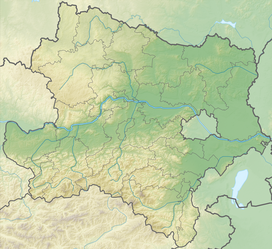Vienna Woods
| Vienna Woods | |
|---|---|
| Wienerwald | |
 Vienna Woods near Breitenfurt | |
| Highest point | |
| Peak | Schöpfl |
| Elevation | 893 m (2,930 ft) |
| Coordinates | 48°05′14″N 015°54′43″E / 48.08722°N 15.91194°E |
| Dimensions | |
| Length | 45 km (28 mi) |
| Width | 20–30 km (12–19 mi) |
| Geography | |
| Country | Austria |
| States | Lower Austria and Vienna |
| Range coordinates | 48°10′N 16°00′E / 48.167°N 16.000°E |
| Parent range | Northern Limestone Alps |
The Vienna Woods[1] (German: Wienerwald, pronounced [ˈviːnɐˌvalt] ⓘ) are forested highlands that form the northeastern foothills of the Northern Limestone Alps in the states of Lower Austria and Vienna. The 45-kilometre-long (28 mi) and 20–30-kilometre-wide (12–19 mi) range of hills is heavily wooded and a popular recreation area with the Viennese.
Location
The Vienna Woods are bounded by the rivers
Geography

The highest elevation in the Vienna Woods is
Even though the Vienna Woods are a
Geology
The mountain ranges of the Vienna Woods are the transition between the
History
The Vienna Woods have probably been populated since the 8th century. The Vienna Woods was the royal hunting grounds from the 11th century until 1850. Under the influence of the
Through the northern part of the Vienna Woods (from
In 1870, plans were brought forward to clear most of the forest, but this caused widespread public resistance, in which Josef Schöffel was one of the most important figures. In 1987, the governors of the states of Vienna, Lower Austria and Burgenland signed the Vienna Woods Declaration to protect nature in the region.
See also
- "Tales from the Vienna Woods", a waltz by Johann Strauss II, as well as a play by Ödön von Horváth, and several film adaptations of the play
References
- ISBN 0-245-51993-9.
- ISBN 3-85084-661-X.
External links
- Austrian Biosphere Reserves
- 360° × 180° panoramic image of the Wienerwald (QuickTime needed)
- Natural Park Sparbach
- Vienna Woods Tourism Information
German language links
- Biosphere Park Wienerwald
- Natural Park of the Föhrenberge (in German)
- Natural Park of Sandstein-Wienerwald (in German)
- Wienerwald (Vienna Woods) – Flora + Fauna (in German)



